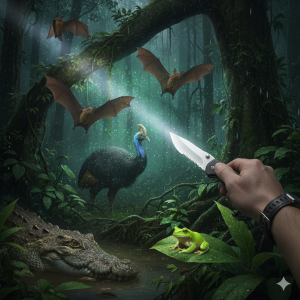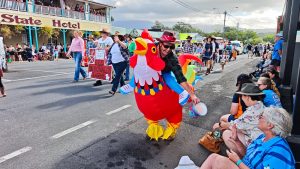Our Yellow Bellied Sunbird story

When visiting the Cassowary Coast the Yellow Bellied Sunbird is another experiance not to be missed…
The Innisfail Cassowary Coast golden Sunbird (cinnyris jugularis) is also locally known as the Australian Yellow Bellied Sunbird.
Some Yellow bellied Sunbird Facts:
 The male is easy recognized with its forehead, throat and upper breast a dark, metallic blue-black or some might call an iridescent dark blue bib with a bright yellow or golden belly.
The male is easy recognized with its forehead, throat and upper breast a dark, metallic blue-black or some might call an iridescent dark blue bib with a bright yellow or golden belly.
The female yellow-bellied Sunbird as the name implies are completely golden underneath, both have an olive back and wings with slender curved beaks and a long darting thread like tongue.
These small sunbirds (about 12 cm or 4.7 inches in size) are from the Old World passerine bird group which largely feed on nectar, but they will also eat insects with a preference for spiders, (if you look closerly you will see a scorpion) especially when rearing their young during the breeding season which is between August and January.

Around the Cassowary Coast region the tiny paired Sunbirds build their nests in and around peoples homes. So you will often see their nests on verandas, in open sheds and sometimes hanging from the clothes lines too.
Baby sunbird chicks are prey to a variety of larger birds like kookaburras and butcher-birds and been in the wet tropics are also prey to the abundant small tree snakes.
Sunbirds are so intelligent…
However having watched our tiny Sunbird, they seem to have learnt that their predators usually avoid places frequented by humans, so building their nests near human habitats is a smart move that affords some protection for the family.
It is really fascinating watching these little sunbirds build their nest on what was my rainforest made wind charm using a huge dry bean pod hanging up under the eaves.
Later I was told that some locals living along the Cassowary Coast often string pieces of rope around their homes to encourage the Sunbirds to build nests.
 With the nest building process complete, we had the added privilege of watching the rearing of the chicks up close, which was a fascinating and humbling experience.
With the nest building process complete, we had the added privilege of watching the rearing of the chicks up close, which was a fascinating and humbling experience.
With some surprises like thinking the sunbirds had abandon their nest straight after they have completed it only to return a week later to lay two eggs.
This we found out another week later, finding a left-over hatched egg on the ground and 8 days after that got our first glance of the chicks heads.

During the week long incubation the female sunbird just didn’t sit in the nest but would leave the nest for quite long periods during the hottest part of the afternoon and return before dusk.
After the chicks have hatched, both male and female assist in caring for the chicks, taking turns in catching mostly spiders to feed the chicks and carrying away their “poo” too, taking the dropping right out of their bottoms.
As with other parents these little sunbirds are the cleanest birds out there, as after feeding they actually clean up after their  little ones, however the female does a better job than her partner.
little ones, however the female does a better job than her partner.
The male sunbird is the family protector which he takes very seriously, chasing away other smaller and not so small birds, intercepting them on the fly if they fly to close to the nest.
Any park car mirrors can be a distraction for the male as he will “seek” his image out, excitedly trying to warn the “other” male away from his territory.
Both can be seen communicate with each other using their persistent cheeping and squealing, listening carefully you can hear different tones/chirping for dangers, warnings, excitement and other emotions.
And then leave the nest about three weeks after been born.
To watch the Sunbirds in flight is a challenge as they fly fast straight and dart around on their short wings.
And to watch them take nectar whilst hovering is a sight to behold indeed, or to take a spider in the middle of the spider’s web in flight too.







We are a group of volunteers bird watchers and love your yellow bellied sunbird. Adelaida Kienan Sitnik